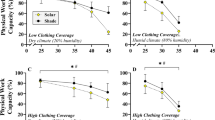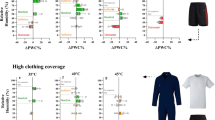Abstract
Combinations of wind-driven convection and environmental radiation in cold weather, make the environment “feel” colder. The relative contributions of these mechanisms, which form the basis for estimating wind chill equivalent temperatures (WCETs), are studied over a wide range of environmental conditions. Distinction is made between direct solar radiation and environmental radiation. Solar radiation, which is not included in the analysis, has beneficial effects, as it counters and offsets some of the effects due to wind and low air temperatures. Environmental radiation effects, which are included, have detrimental effects in enhancing heat loss from the human body, thus affecting the overall thermal sensation due to the environment. The analysis is performed by a simple, steady-state analytical model of human–environment thermal interaction using upper and lower bounds of environmental radiation heat exchange. It is shown that, over a wide range of relevant air temperatures and reported wind speeds, convection heat losses dominate over environmental radiation. At low wind speeds radiation contributes up to about 23% of the overall heat loss from exposed skin areas. Its relative contributions reduce considerably as the time of the exposure prolongs and exposed skin temperatures drop. At still higher wind speeds, environmental radiation effects become much smaller contributing about 5% of the total heat loss. These values fall well within the uncertainties associated with the parameter values assumed in the computation of WCETs. It is also shown that environmental radiation effects may be accommodated by adjusting reported wind speeds slightly above their reported values.





Similar content being viewed by others
References
ASHRAE (1997) Thermal comfort. In: Owen MS (ed) ASHRAE handbook-fundamentals volume. American Society of Heating, Refrigerating and Air Conditioning Engineers, Atlanta, pp 8.1–8.28
Bluestein M (1998) An evaluation of the wind chill factor: its development and applicability. J Biomech Eng 120:255–258
Environment Canada (2001) Canada’s new wind chill index. Available online at: http://www.mb.ec.gc.ca/air/wintersevere/windchill.en.html
Froese G, Burton AC (1957) Heat losses from the human head. J Appl Physiol 10(2):235–241
Geiger R (1971) The climate near the ground. Harvard University Press, Cambridge, MA
Carvalho MG (1996) Radiative heat transfer. In: Hewitt GF, Shires GL, Polezhaev YV (eds) International encyclopedia of heat and mass transfer. CRC Press, New York, pp 913–926
Incropera FP, DeWitt DP (1996) Introduction to heat transfer, 3rd ed. Wiley, p 10
Kessler E (1993) Wind chill errors. Bull Am Meteor Soc 74:1743–1744
Kreith F (1973) Principles of heat transfer, 3rd ed. Harper and Row, New York
Molnar GW (1958) An evaluation of wind chill. In: Horvath SM (ed) Cold injury. Proceedings of the 6th Conference, US Army Medical Research Laboratory, Fort Knox, KY, Capital City Press, Montpelier, VT, pp 175–221
National Weather Service USA (2001) Wind chill temperature index. Available online at: http://www.nws.noaa.gov/om/windchill/index.shtml
Osczevski RJ (1995) The basis of wind chill. Arctic 48:372–382
Osczevski RJ, Bluestein M (2005) The new wind chill equivalent temperature chart. Bull Am Meteor Soc 86:1453–1458
Shitzer A (2006a) Wind chill equivalent temperatures – regarding the impact due to the variability of the environmental convection heat transfer coefficient. Int J Biometeor 50(4):224–232
Shitzer A (2006b) A parametric analysis of wind chill equivalent temperatures by a dimensionless, steady-state analysis. Int J Biometeor 50(4):215–223
Siple P, Passel CF (1945) Measurements of dry atmospheric cooling in subfreezing temperatures. Proc Am Phil Soc 89(1):177–199
Steadman R (1984) A universal scale of apparent temperature. J Clim Appl Meteor 23:1674–1687
Tikuisis P, Osczevski RJ (2002) Dynamic model of facial cooling. J Appl Meteorol 12:1241–1246
Tikuisis P, Osczevski RJ (2003) Facial cooling during cold air exposure. Bull Am Meteor Soc 84:927–933
Togawa T (1989) Non-contact skin emissivity: measurement from reflectance using step change in ambient radiation temperature. Clin Phys Physiol Meas 10(1):39–48
Acknowledgment
This study was supported in part by the James H. Belfer Chair in Mechanical Engineering at the Technion, Israel Institute of Technology.
Author information
Authors and Affiliations
Corresponding author
Rights and permissions
About this article
Cite this article
Shitzer, A. Assessment of the effects of environmental radiation on wind chill equivalent temperatures. Eur J Appl Physiol 104, 215–220 (2008). https://doi.org/10.1007/s00421-007-0624-3
Accepted:
Published:
Issue Date:
DOI: https://doi.org/10.1007/s00421-007-0624-3




